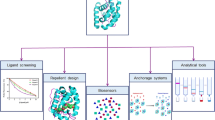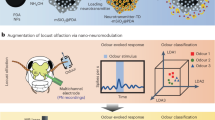Abstract
The olfactory system of living organisms can accurately discriminate numerous odors by recognizing the pattern of activation of several odorant receptors (ORs). Thus, development of an odorant sensor array based on multiple ORs presents the possibility of mimicking biological odor discrimination mechanisms. Recently, we developed novel odorant sensor elements with high sensitivity and selectivity based on insect OR-expressing Sf21 cells that respond to target odorants by displaying increased fluorescence intensity. Here we introduce the development of an odorant sensor array composed of several Sf21 cell lines expressing different ORs. In this study, an array pattern of four cell lines expressing Or13a, Or56a, BmOR1, and BmOR3 was successfully created using a patterned polydimethylsiloxane film template and cell-immobilizing reagents, termed biocompatible anchor for membrane (BAM). We demonstrated that BAM could create a clear pattern of Sf21 sensor cells without impacting their odorant-sensing performance. Our sensor array showed odorant-specific response patterns toward both odorant mixtures and single odorant stimuli, allowing us to visualize the presence of 1-octen-3-ol, geosmin, bombykol, and bombykal as an increased fluorescence intensity in the region of Or13a, Or56a, BmOR1, and BmOR3 cell lines, respectively. Therefore, we successfully developed a new methodology for creating a cell-based odorant sensor array that enables us to discriminate multiple target odorants. Our method might be expanded into the development of an odorant sensor capable of detecting a large range of environmental odorants that might become a promising tool used in various applications including the study of insect semiochemicals and food contamination.






Similar content being viewed by others
References
Atherton TJ, Kerbyson DJ (1999) Size invariant circle detection. Image Vis Comput 17:795–803
Chen TW, Wardill TJ, Sun Y, Pulver SR, Renninger SL, Baohan A, Schreiter ER, Kerr RA, Orger MB, Jayaraman V, Looger LL, Svoboda K, Kim DS (2013) Ultrasensitive fluorescent proteins for imaging neuronal activity. Nature 499:295–300
Crasto C, Marenco L, Miller P, Shepherd G (2002) Olfactory receptor database: a metadata-driven automated population from sources of gene and protein sequences. Nucleic Acids Res 30:354–360
Figueroa XA, Cooksey GA, Votaw SV, Horowitz LF, Folch A (2010) Large-scale investigation of the olfactory receptor space using a microfluidic microwell array. Lab Chip 10:1120–1127
Galizia CG, Münch D, Strauch M, Nissler A, Ma S (2010) Integrating heterogeneous odor response data into a common response model: a DoOR to the complete olfactome. Chem Senses 35:551–563
Kato K, Umezawa K, Funeriu DP, Miyake M, Miyake J, Nagamune T (2003) Immobilized culture of nonadherent cells on an oleyl poly (ethylene glycol) ether-modified surface. Biotechniques 35:1014–1021
Mitsuno H, Sakurai T, Namiki S, Mitsuhashi H, Kanzaki R (2015) Novel cell-based odorant sensor elements based on insect odorant receptors. Biosens Bioelectron 65C:287–294
Myrick AJ, Park KC, Hetling JR, Baker TC (2009) Detection and discrimination of mixed odor strands in overlapping plumes using an insect-antenna-based chemosensor system. J Chem Ecol 35:118–130
Nakagawa T, Sakurai T, Nishioka T, Touhara K (2005) Insect sex-pheromone signals mediated by specific combinations of olfactory receptors. Science 307:1638–1642
Oh EH, Lee SH, Lee SH, Ko HJ, Park TH (2014) Cell-based high-throughput odorant screening system through visualization on a microwell array. Biosens Bioelectron 53:18–25
Park KC, Ochieng SA, Zhu J, Baker TC (2002) Odor discrimination using insect electroantennogram responses from an insect antennal array. Chem Senses 27:343–352
Ressler KJ, Sullivan SL, Buck LB (1994) Information coding in the olfactory system: evidence for a stereotyped and highly organized epitope map in the olfactory bulb. Cell 79:1245–1255
Sato K, Pellegrino M, Nakagawa T, Nakagawa T, Vosshall LB, Touhara K (2008) Insect olfactory receptors are heteromeric ligand-gated ion channels. Nature 452:1002–1006
Takano T, Yamaguchi S, Matsunuma E, Komiya S, Shinkai M, Takezawa T, Nagamune T (2012) Cell transfer printing from patterned poly (ethylene glycol)- oleyl surfaces to biological hydrogels for rapid and efficient cell micropatterning. Biotechnol Bioeng 109:244–251
Yamaguchi S, Yamahira S, Kikuchi K, Sumaru K, Kanamori T, Nagamune T (2012) Photocontrollable dynamic micropatterning of non-adherent mammalian cells using a photocleavable poly (ethylene glycol) lipid. Angew Chemie Int Ed Engl 51:128–131
Yuen HK, Princen J, Illingworth J, Kittler J (1990) Comparative study of Hough transform methods for circle finding. Image Vis Comp 8:71–77
Acknowledgments
This research was supported by the Secom Science and Technology Foundation and the Research Promotion Program for Science and Technology for Agriculture, Forestry and Fisheries industry and the Food Production Industry. The authors thank Prof. Takamichi Nakamoto (Tokyo Institute of Technology) for helpful advice and discussions, Dr. Shigeru Matsuyama for providing bombykol and bombykal, Dr. Douglas S. Kim for providing the GCaMP6s gene, Mrs. Yuko Nakajima for construction of the Sf21 cell lines, Dr. Shigehiro Namiki and Ms. Akiko Tanaka for providing image processing MATLAB codes, and Mr. Ryuji Misawa for technical support in the BAM coating experiment.
Author information
Authors and Affiliations
Corresponding author
Additional information
Maneerat Termtanasombat and Hidefumi Mitsuno contributed equally to this work.
Rights and permissions
About this article
Cite this article
Termtanasombat, M., Mitsuno, H., Misawa, N. et al. Cell-Based Odorant Sensor Array for Odor Discrimination Based on Insect Odorant Receptors. J Chem Ecol 42, 716–724 (2016). https://doi.org/10.1007/s10886-016-0726-7
Received:
Revised:
Accepted:
Published:
Issue Date:
DOI: https://doi.org/10.1007/s10886-016-0726-7




